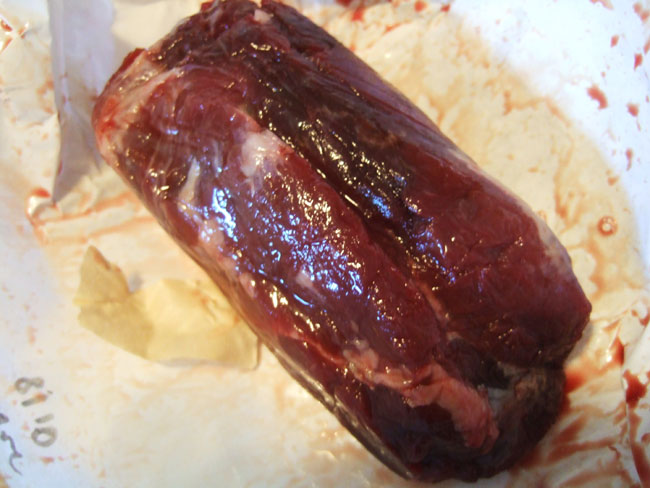 Bloody beaver.
Bloody beaver.
My first challenge after my beaver meat arrived was to put it in some historical context and to see if there was a precedent for beaver eating.  I turned to Thomas De Voe, the man in charge of New York City’s food markets in the middle of the 19th century, who also wrote The Market Assistant: Containing a brief description of every article of human food sold in the public markets of the cities of New York, Boston, Philadelphia, and Brooklyn; including the various domestic and wild animals, poultry, game, fish, vegetables, fruits &c., &c. with many curious incidents and anecdotes. Did he know how indispensable his book would be to future historians?
I checked out his passage on beaver and came to an amazing realization: Victorians weren’t eating beaver, because by the middle of the 19th century, they had hunted it to near extinction. Â Beaver pelts were too valuable for their fashion cred, in terms of muffs, coats, and hats. Â Here’s what De Voe says:
This animal was once a native here, but civilization and the beaver’s valued skin have almost exterminated the family, although now and then a specimen is taken in our State. It is said the ‘flesh of this animal is greatly prized by hunters and voyageurs, especially when roasted in the skin after the fur is singed off. ‘ Â This of course is an expensive luxury and is frowned upon by the fur traders. Â ‘Care must be taken, however, to examine the herbage on which the animals feed, or mischief may follow an unwary repast. Â Mr. Ross’s party were once poisoned by feasting heartily on beaver and some of them had a very narrow escape. Â The Indians eat this kind of beaver but they roast it; boiled, they say, it is pernicious.’
Professor Kalm, in his ‘Travels in America,’ in 1748, says ‘Beaver flesh is eaten, not only by the Indians, but likewise by the Europeans, and especially by the French on their fasting days; for his Holiness, in his system, has ranged the beaver among the fish. The flesh is reckoned best if the beaver has lived upon vegetables. The tail is likewise eaten after it has been well boiled and roasted afterwards.
So, according to what De Voe has heard: 1. Beaver is good roasted. 2. Beaver can be poisonous. Â (Perhaps not poison, but I suspect, that like bear, the beaver’s diet varies by season from one based heavily on plants and berries, to one based on fish. Â The latter can give the meat an unpleasant, fishy taste. ) 3. Â A beaver is a fish, therefore it can be eaten on Fridays. Â (Good news for you Catholics out there.) 4. Beaver tail is damn tasty.
I know number three to be true, thanks to a great post at the French Culinary Institutes’s blog, Cooking Issues.  Not too long ago, they ordered up some exotic meats from Crizmer’s outside of Chicago, including both beaver tail and beaver flapper, which are two different things.  Of the beaver tail, they said “Beaver tail is straight up fantastic. It has a woody-musky aroma and flavor that is unique among all meats I have tried…Man, was it good.”  This statement gave me hope, as I prepped my beaver meat for consumption.
Tomorrow: recipes and the big beaver tasting.

0 Responses to “Beaver Bonanza Part II: A Brief History of Beaver”